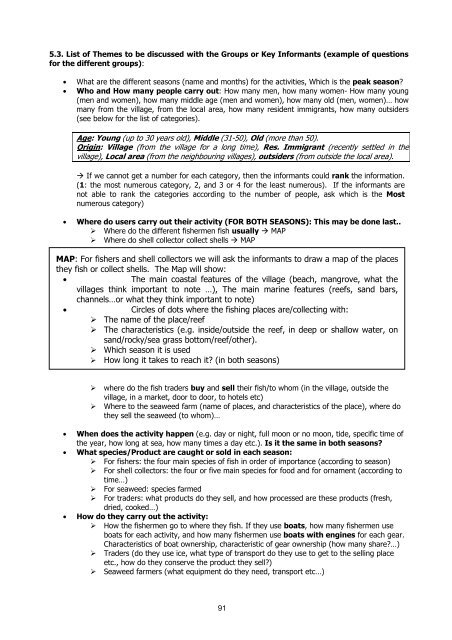a socio-economic baseline assessment of the mnazi bay - IUCN
a socio-economic baseline assessment of the mnazi bay - IUCN
a socio-economic baseline assessment of the mnazi bay - IUCN
You also want an ePaper? Increase the reach of your titles
YUMPU automatically turns print PDFs into web optimized ePapers that Google loves.
5.3. List <strong>of</strong> Themes to be discussed with <strong>the</strong> Groups or Key Informants (example <strong>of</strong> questions<br />
for <strong>the</strong> different groups):<br />
• What are <strong>the</strong> different seasons (name and months) for <strong>the</strong> activities, Which is <strong>the</strong> peak season?<br />
• Who and How many people carry out: How many men, how many women- How many young<br />
(men and women), how many middle age (men and women), how many old (men, women)… how<br />
many from <strong>the</strong> village, from <strong>the</strong> local area, how many resident immigrants, how many outsiders<br />
(see below for <strong>the</strong> list <strong>of</strong> categories).<br />
Age: Young (up to 30 years old), Middle (31-50), Old (more than 50).<br />
Origin: Village (from <strong>the</strong> village for a long time), Res. Immigrant (recently settled in <strong>the</strong><br />
village), Local area (from <strong>the</strong> neighbouring villages), outsiders (from outside <strong>the</strong> local area).<br />
If we cannot get a number for each category, <strong>the</strong>n <strong>the</strong> informants could rank <strong>the</strong> information.<br />
(1: <strong>the</strong> most numerous category, 2, and 3 or 4 for <strong>the</strong> least numerous). If <strong>the</strong> informants are<br />
not able to rank <strong>the</strong> categories according to <strong>the</strong> number <strong>of</strong> people, ask which is <strong>the</strong> Most<br />
numerous category)<br />
• Where do users carry out <strong>the</strong>ir activity (FOR BOTH SEASONS): This may be done last..<br />
Where do <strong>the</strong> different fishermen fish usually MAP<br />
Where do shell collector collect shells MAP<br />
MAP: For fishers and shell collectors we will ask <strong>the</strong> informants to draw a map <strong>of</strong> <strong>the</strong> places<br />
<strong>the</strong>y fish or collect shells. The Map will show:<br />
• The main coastal features <strong>of</strong> <strong>the</strong> village (beach, mangrove, what <strong>the</strong><br />
villages think important to note …), The main marine features (reefs, sand bars,<br />
channels…or what <strong>the</strong>y think important to note)<br />
• Circles <strong>of</strong> dots where <strong>the</strong> fishing places are/collecting with:<br />
The name <strong>of</strong> <strong>the</strong> place/reef<br />
The characteristics (e.g. inside/outside <strong>the</strong> reef, in deep or shallow water, on<br />
sand/rocky/sea grass bottom/reef/o<strong>the</strong>r).<br />
Which season it is used<br />
How long it takes to reach it? (in both seasons)<br />
where do <strong>the</strong> fish traders buy and sell <strong>the</strong>ir fish/to whom (in <strong>the</strong> village, outside <strong>the</strong><br />
village, in a market, door to door, to hotels etc)<br />
Where to <strong>the</strong> seaweed farm (name <strong>of</strong> places, and characteristics <strong>of</strong> <strong>the</strong> place), where do<br />
<strong>the</strong>y sell <strong>the</strong> seaweed (to whom)…<br />
• When does <strong>the</strong> activity happen (e.g. day or night, full moon or no moon, tide, specific time <strong>of</strong><br />
<strong>the</strong> year, how long at sea, how many times a day etc.). Is it <strong>the</strong> same in both seasons?<br />
• What species/Product are caught or sold in each season:<br />
For fishers: <strong>the</strong> four main species <strong>of</strong> fish in order <strong>of</strong> importance (according to season)<br />
For shell collectors: <strong>the</strong> four or five main species for food and for ornament (according to<br />
time…)<br />
For seaweed: species farmed<br />
For traders: what products do <strong>the</strong>y sell, and how processed are <strong>the</strong>se products (fresh,<br />
dried, cooked…)<br />
• How do <strong>the</strong>y carry out <strong>the</strong> activity:<br />
How <strong>the</strong> fishermen go to where <strong>the</strong>y fish. If <strong>the</strong>y use boats, how many fishermen use<br />
boats for each activity, and how many fishermen use boats with engines for each gear.<br />
Characteristics <strong>of</strong> boat ownership, characteristic <strong>of</strong> gear ownership (how many share?…)<br />
Traders (do <strong>the</strong>y use ice, what type <strong>of</strong> transport do <strong>the</strong>y use to get to <strong>the</strong> selling place<br />
etc., how do <strong>the</strong>y conserve <strong>the</strong> product <strong>the</strong>y sell?)<br />
Seaweed farmers (what equipment do <strong>the</strong>y need, transport etc…)<br />
91
















